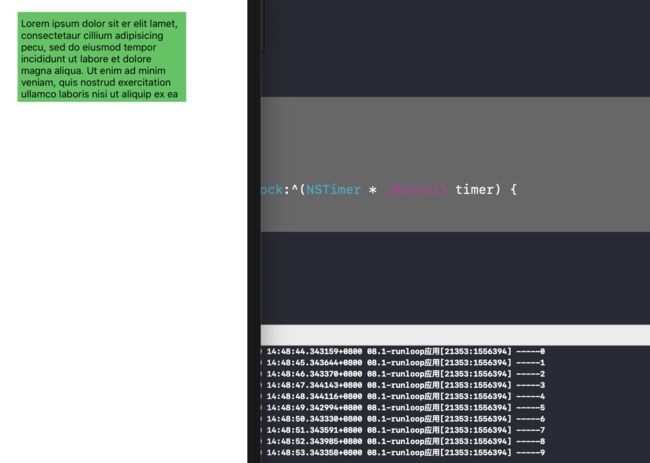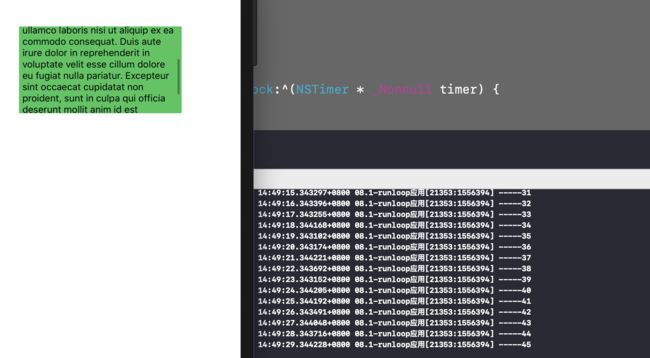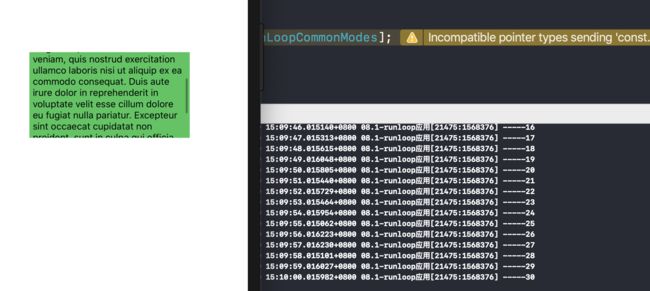我们在平时开发过程中涉及到runloop相关的应用场景大致有如下几种:
- NSTimer创建的定时器在滑动过程中失效
- 控制线程的生命周期
- 多线程
- AutoreleasePool释放对象
- ...
我们先来验证NSTimer创建的定时器,在滚动ScrollView时,定时器就会停止工作的问题,示例代码如下:
- (void)viewDidLoad {
[super viewDidLoad];
// Do any additional setup after loading the view.
static int num = 0;
[NSTimer scheduledTimerWithTimeInterval:1 repeats:YES block:^(NSTimer * _Nonnull timer) {
NSLog(@"-----%d",num ++);
}];
}
我们在当前控制器View上添加一个UITextView控件,然后在viewDidLoad函数中创建一个定时器,当我们运行项目,定时器可以正常的工作,打印结果如图:
当我们滚动UITextView时,发现定时器打印就停止了,如图:
这是因为当没有ScrollView滚动事件时,此时的runloop模式为默认模式kCFRunLoopDefaultMode,当我们滚动ScrollView时,这时runloop的模式就由kCFRunLoopDefaultMode切换为UITrackingRunLoopMode,UITrackingRunLoopMode只处理滚动相关的任务,所以此时的NSTimer定时器就失效不能正常工作了,那我们怎么处理即可以让Timer能正常工作,又可以滚动TextView尼?
这时我们可以切换当前runloop的模式,将kCFRunLoopDefaultMode改为kCFRunLoopCommonModes模式,代码如下:
- (void)viewDidLoad {
[super viewDidLoad];
// Do any additional setup after loading the view.
static int num = 0;
NSTimer *timer = [NSTimer scheduledTimerWithTimeInterval:1 repeats:YES block:^(NSTimer * _Nonnull timer) {
NSLog(@"-----%d",num ++);
}];
// 将kCFRunLoopDefaultMode改为kCFRunLoopCommonModes
[[NSRunLoop currentRunLoop] addTimer:timer forMode:NSRunLoopCommonModes];
}
从打印可以看出,当我们滚动UITextView时,Timer定时器还是可以正常的工作
关于NSTimer在runloop中的运用,还有一点需要注意,这时我们换一种创建Timer的方式,代码如下:
- (void)viewDidLoad {
[super viewDidLoad];
// Do any additional setup after loading the view.
static int num = 0;
NSTimer *timer = [NSTimer timerWithTimeInterval:1 repeats:YES block:^(NSTimer * _Nonnull timer) {
NSLog(@"---%d", num ++);
}];
}
此时我们发现,使用timerWithTimeInterval:方式创建的Timer,运行项目发现定时器不工作,而使用scheduledTimerWithTimeInterval:方式创建的Timer,直接运行项目Timer是可以正常的工作的,这又是因为什么?
系统提供的两种创建Timer的方式:
/// Creates and returns a new NSTimer object initialized with the specified block object. This timer needs to be scheduled on a run loop (via -[NSRunLoop addTimer:]) before it will fire.
+ (NSTimer *)timerWithTimeInterval:(NSTimeInterval)interval repeats:(BOOL)repeats block:(void (^)(NSTimer *timer))block API_AVAILABLE(macosx(10.12), ios(10.0), watchos(3.0), tvos(10.0));
/// Creates and returns a new NSTimer object initialized with the specified block object and schedules it on the current run loop in the default mode.
+ (NSTimer *)scheduledTimerWithTimeInterval:(NSTimeInterval)interval repeats:(BOOL)repeats block:(void (^)(NSTimer *timer))block API_AVAILABLE(macosx(10.12), ios(10.0), watchos(3.0), tvos(10.0));
我们从上面两种创建Timer的官方文档注释中可以看出,scheduledTimerWithTimeInterval:是经过定制化的,此函数创建出来的Timer已经自动添加到当前的runloop中了,并且是在默认的模式下的,而timerWithTimeInterval:创建出来的Timer并没有自动添加到runloop中,需要开发者手动创建runloop并将timer添加到runloop中timer才可以正常运行,我们修改代码如下:
- (void)viewDidLoad {
[super viewDidLoad];
// Do any additional setup after loading the view.
static int num = 0;
NSTimer *timer = [NSTimer timerWithTimeInterval:1 repeats:YES block:^(NSTimer * _Nonnull timer) {
NSLog(@"---%d", num ++);
}];
// 创建一个runloop,并将timer添加到创建的runloop中
[[NSRunLoop currentRunLoop] addTimer:timer forMode:NSRunLoopCommonModes];
}
我们再次运行项目,发现此时timer就可以正常运行了,并且我们滚动TextView也可以正常打印而不会导致timer停止工作
讲解示例Demo地址:https://github.com/guangqiang-liu/08.1-RunloopDemo2
更多文章
- ReactNative开源项目OneM(1200+star):https://github.com/guangqiang-liu/OneM:欢迎小伙伴们 star
- iOS组件化开发实战项目(500+star):https://github.com/guangqiang-liu/iOS-Component-Pro:欢迎小伙伴们 star
- 主页:包含多篇iOS和RN开发相关的技术文章http://www.jianshu.com/u/023338566ca5 欢迎小伙伴们:多多关注,点赞
- ReactNative QQ技术交流群(2000人):620792950 欢迎小伙伴进群交流学习
- iOS QQ技术交流群:678441305 欢迎小伙伴进群交流学习


